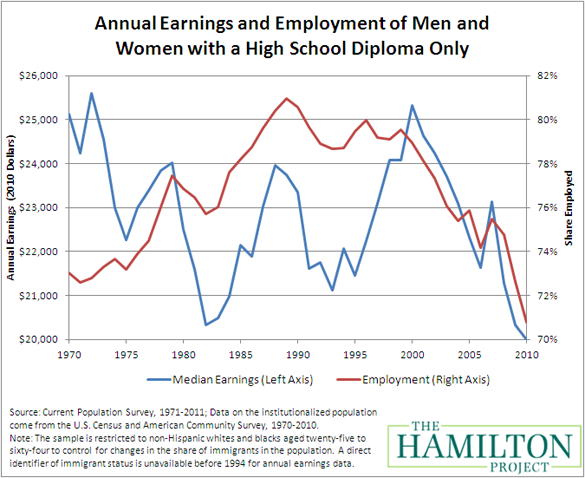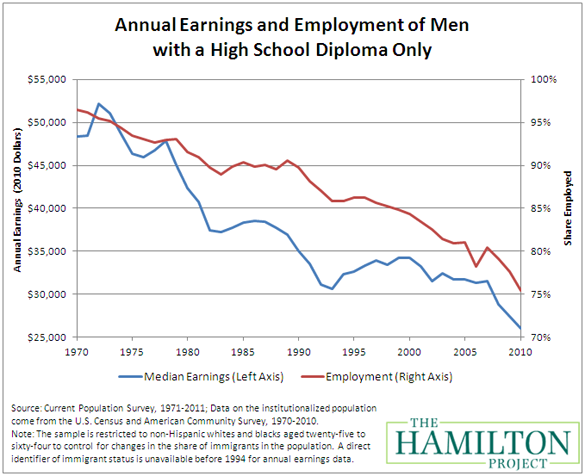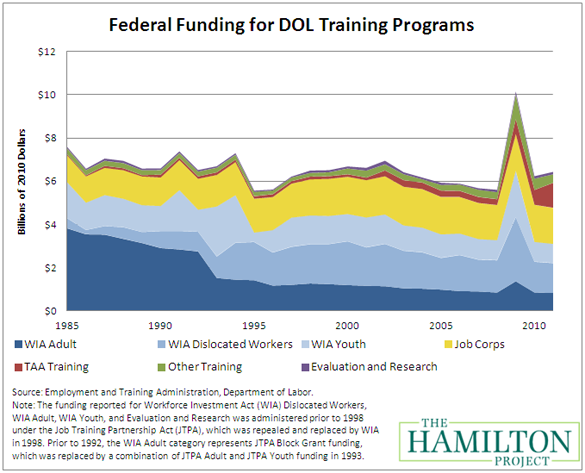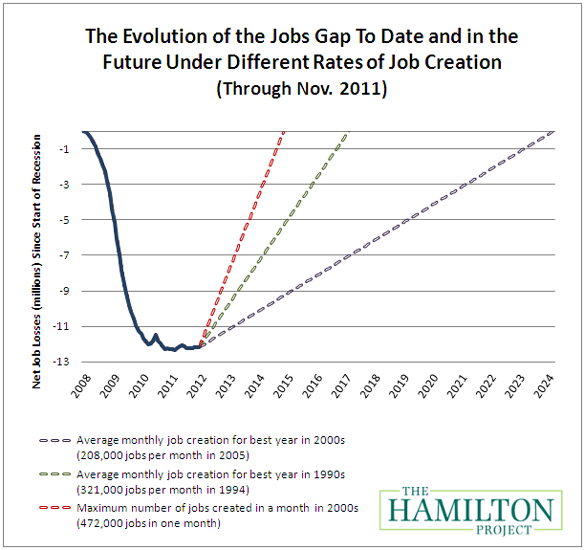The labor market continued to expand at a modest pace last month, according to today’s employment report. Payroll employment increased by 120,000 jobs in November, and the fraction of Americans with a job ticked up. Including revisions to previous months, total employment was 192,000 higher in November. Private employment increased by 140,000 jobs last month while governments continued to shed jobs. While the unemployment rate jumped down to 8.6 percent, some of the reduction reflected lower labor force participation rather than increases in employment.
While overall job creation has improved slightly, many American workers continue to face serious difficulties in the labor market. These workers tend to have less formal education and/or fewer job-relevant skills. For less-educated workers, the Great Recession has only exacerbated a longer-term trend of diminished earnings and job opportunities.
In this month’s analysis, The Hamilton Project explores the employment and earnings trends facing America’s less-educated workers over the last few decades, and highlights training and workforce development opportunities that could be part of the policy solution. We also continue to explore the “jobs gap,” or the number of jobs that the U.S. economy needs to create in order to return to pre-recession employment levels while also absorbing the 125,000 people who enter the labor force each month.
Long-Term Earnings of Less-Skilled Workers
Forty years ago, a high school education gave workers the skills they needed to hold down middle-class jobs and to participate in the gains of a growing economy. Virtually all men, from those with only a high school diploma to those with college degrees, were gainfully employed. Since then, the job prospects and earnings of the typical high school graduate have fallen far behind those of better-educated workers.
As shown in the figure below, the employment rates and median earnings of Americans with only a high school degree have declined considerably over the past 40 years, despite the rapid increase in employment among women through the 1970s and 1980s. In short, the solid gains made by women over the years have only partially offset the considerable losses experienced by men over the same period. Moreover, the earnings of the median high school graduate are lower today than they were in the early 1970s, after adjusting for inflation. This trend is particularly evident over the last two decades during which employment rates have fallen from a high of 81 percent in 1989 to 71 percent today.

Given the many legal and social barriers that held women back during this period, it is also informative to take a more focused look at the plight of male workers. The employment rate for male high school graduates has fallen from 96 percent in 1970 to only 75 percent today, as shown below. Median annual earnings are just $26,000 today—about half of the $50,000 the median man with a high school diploma brought home forty years ago.

In recent years, rapid technological changes and increasing global competition have continued to deliver great economic benefits to Americans, through lower prices for consumer goods, advances in health care that prolong our lives, and improvements in the quality and capabilities of everyday products. But this dynamism and rapid change of the American economy has caused some workers’ skills to become less valuable due to forces that are beyond their control. As such, the availability of effective training programs is a vital complement to the continued pursuit of policies that facilitate the dynamism that characterize our economy. Policies to improve the education and skills of workers can play an important role in putting Americans back to work in good-paying jobs.
On November 30, The Hamilton Project hosted a forum and released two new policy proposals that provide evidence-based, cost-effective approaches to worker training—both of which are designed to increase earnings and employment prospects.
- “Raising Job Quality and Skills for American Workers: Creating More-Effective Education and Workforce Development Systems in the States,” by Harry J. Holzer of Georgetown University, builds on the success of sectoral training programs for disadvantaged workers to create a competitive grant system. This system will give states funding for creating partnerships between training providers and employers or industry groups. The grants would fund a more effective workforce and education system that provides students and training participants with the skills that employers demand by directly linking their education and training with the labor market.
- “Policies to Reduce High-Tenured Displaced Workers’ Earnings Losses through Retraining,” by Louis S. Jacobson of New Horizons Economic Research, Robert J. LaLonde of the University of Chicago, and Daniel G. Sullivan of the Federal Reserve Bank of Chicago, focuses on the problem of retraining displaced workers who have experienced significant earnings losses due to lower wages after reemployment. The paper proposes the establishment of a Displaced Worker Training (DWT) program administered by the U.S. Department of Labor to provide sizeable grants for longer-term training and utilizes honest brokers to assess and counsel grantees to increase the returns to the DWT program.
Despite the promise of these emerging training models, government resources have already been stretched thin even as more unemployed workers turn to existing programs for assistance. The graph below shows the budget for Department of Labor training programs from 1985 to the present. Spending has slowly fallen since the beginning of this period, aside from a 2009 bump due to the American Recovery and Reinvestment Act and some recent new programs. Furthermore, in the late 1970s, funding for the Job Training Partnership Act, the predecessor of the current Workforce Investment Act, was more than $15 billion. The decline becomes even sharper when this spending is expressed on a per worker basis or as a percentage of GDP.

In today’s tough budgetary environment, it is more important than ever to make sure that training funds are targeted toward the most effective programs in order to provide best possible outcomes for American workers. In a new Hamilton Project strategy paper, “Building America’s Job Skills with Effective Workforce Programs: A Training Strategy to Raise Wages and Increase Work Opportunities,” we propose two general principles that can guide policy-makers in improving the performance of training programs: (1) training funds should be directed to programs with a track record of success in improving earnings for the specific target population and to those workers who can benefit the most from those programs; and (2) training programs should directly engage employer and industry partners, or actively guide students to career-specific training.
The November Jobs Gap
As of November, our nation continues to face a “jobs gap” of 12.2 million jobs, down by 67,000 jobs from October.
The chart below shows how the jobs gap has evolved since the start of the Great Recession in December 2007, and how long it will take to close under different assumptions for job growth. The solid line shows the net number of jobs lost since the Great Recession began. The broken lines track how long it will take to close the jobs gap under alternative assumptions about the rate of job creation going forward.

If the economy adds about 208,000 jobs per month, which was the average monthly rate for the best year of job creation in the 2000s, then it will take until February 2024—over 12 years—to close the jobs gap. Given a more optimistic rate of 321,000 jobs per month, which was the average monthly rate for the best year of job creation in the 1990s, the economy will reach pre-recession employment levels by February 2017—not for another five years.
Conclusion
The United States faces a long road to recovery from the Great Recession, and for many workers, the recent downturn is a continuation of long-term stagnation and decline in wages and employment.
While rapid technological change and increasing local competition have continued to deliver great economic benefits to Americans, these phenomena have also dramatically altered the labor market. Forty years ago, a high school education provided a path to a middle-class job, but today, even those with a high school degree often find that they do not have the skills to hold jobs in high-growth industries.
Education and training programs have been an important policy tool to help American workers find good jobs. But as the marketplace changes, so must these initiatives. New evidence highlights the importance of training in high-return fields that can help prepare workers for well-paid jobs of the future. This requires counseling to help guide participants to the best training programs for their abilities and ample opportunity to participate in these programs, which are often in short supply due to their expense. For other workers, more structured education and training programs can help build basic skills that allow them to fully participate in the labor market—sometimes for the first time.
The U.S. workforce is at a crossroads and we need the skills to compete in today’s economy. By focusing resources on the education and training programs with a proven track record of success, and finding new resources to expand American skills, we can better prepare today’s workers, and future generations, for the global marketplace.
The Brookings Institution is committed to quality, independence, and impact.
We are supported by a diverse array of funders. In line with our values and policies, each Brookings publication represents the sole views of its author(s).




Commentary
What Is Happening to America’s Less-Skilled Workers? The Importance of Education and Training in Today’s Economy
December 2, 2011